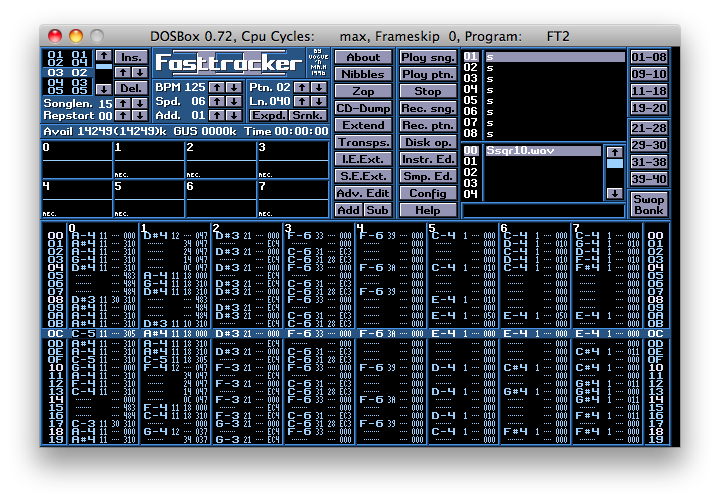With the full D-Pad Hero 2 source code in hand, you might be interested in some more information on how it all works; what would it take to, say, add new playable songs? Let’s begin by examining the core of DH2: The song data.
The song data consists of two distinct parts: The music data, and the level data (AKA “object data” or “target data”). The music data is, unsurprisingly, the song (background music) itself. The level data defines the objects that come flying down the screen during play; their position (lane), timing and type.
Songs are composed as described in this video. At the composing stage, no consideration needs to be made with regards to how a song will be played in D-Pad Hero, i.e. the song can be composed freely.
Once the core song is ready, it must be “mapped” in order to make it playable in D-Pad Hero — that is, level data must be created. The mapping process is technically very similar to composing; instead of sequencing musical notes, you sequence the objects that the player can hit. In fact, we’re using the same tool (FastTracker 2) for creating both the music data and level data! The level data is placed in a separate channel (track), one per difficulty level (beginner - normal - expert). In such a channel, a note corresponds to one or more lanes in the game; for example, C corresponds to the left-most lane, E corresponds to the middle lane, and A corresponds to the two right-most lanes. Furthermore, the effect columns are used to encode the object type (0 = orb, 1 = skull, 2 = POW, and so on). It’s maybe not the most visually luxurious approach to mapping, and it’s not “realtime”; you typically map a small segment of the song, load up the game, try the song, make adjustments to the mapping; repeat. But it’s pretty effective once you get used to it (ask Andreas ![]() ).
).

Excerpt from “Whip Man”. Channels 0 through 4 contain the music (square 0, square 1, triangle, noise, DPCM). Channels 5 through 7 contain the mapping (beginner, normal, expert).
The xm2btn tool (part of the DH2 source code repository) extracts the song’s mapping and creates level data in a packed format that is essentially a list of (lane specifier(s), object type(s), time units until next occurrence) tuples. The level data is completely decoupled from the music data; the music is only used to drive the level data processing (by issuing a callback every time the song advances by one unit (row)). This means that changes can be made to a song or its mapping without affecting the other, and entirely new mappings can easily be accommodated (in order to support more difficulty levels, for instance).
Markers can be inserted in a mapping to define segments (”clips”) of a song. These segments are used in DH2’s final (”boss battle”) stage to create the “mega-mix” containing parts from all songs. FT2 effect 700 indicates the beginning/end of a segment in the mapping. The order of segments in the DH2 “mega-mix” is hard-coded (see the clips label in game.asm).
In D-Pad Hero 2 there are eight possible “challenges” that can be completed for each song (e.g. “Streak over 100″, “Blow up all POWs”). Care must be taken when designing a mapping to ensure that the challenges are actually possible to complete (e.g. are all letters that spell “D-PAD HERO” present?), and that there’s some balance between the various difficulty levels. To help with this, the xm2btn tool prints some statistics about the objects that occur in each lane, per difficulty level:
***** Statistics for targetdata/ripetargets.xm *****
EASY
L R S B A Total
Orb 75 56 49 53 62 295
Skull 22 17 6 16 16 77
POW 4 3 6 3 2 18
Star 1 0 1 0 1 3
Clock 4 0 2 0 1 7
Letter 1 2 3 0 2 8
F-skull 0 0 2 1 0 3
NORMAL
L R S B A Total
Orb 90 79 44 86 102 401
Skull 28 50 19 57 32 186
POW 3 1 10 1 0 15
Star 1 1 0 1 1 4
Clock 2 1 0 1 0 4
Letter 0 1 3 0 4 8
F-skull 0 2 0 0 1 3
HARD
L R S B A Total
Orb 113 92 46 128 133 512
Skull 70 69 30 78 56 303
POW 1 0 0 0 0 1
Star 0 0 0 1 1 2
Clock 1 0 0 0 1 2
Letter 4 2 2 0 0 8
F-skull 0 1 1 1 0 3
In D-Pad Hero 2, the challenges are the same for all songs; the only variable is the score limit in the “Score over XXXXX” challenge, which should reflect the difficulty and maximum obtainable score. These limits are defined in rock_score_table in game.asm.
That should cover the basics of song data in D-Pad Hero 2. The game engine takes care of the rest; I’ll leave that for a future behind-the-scenes special.


